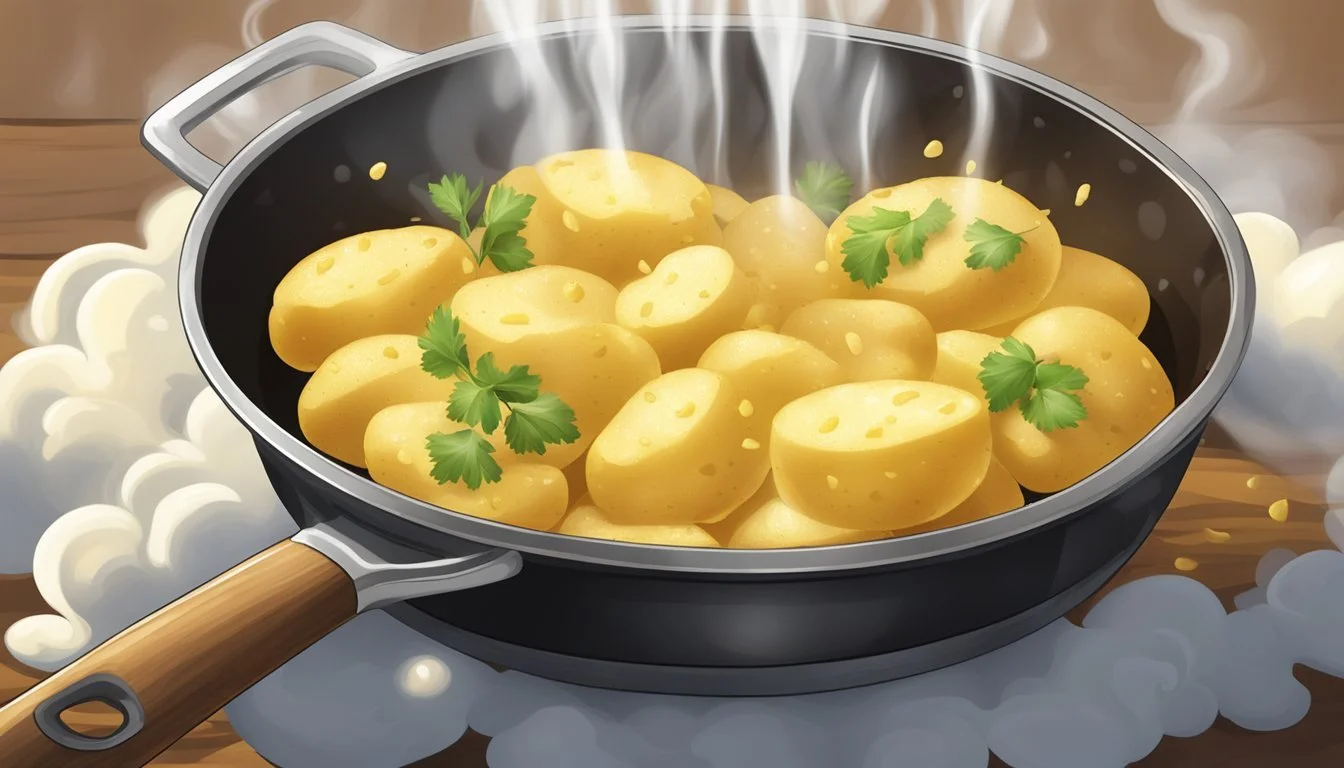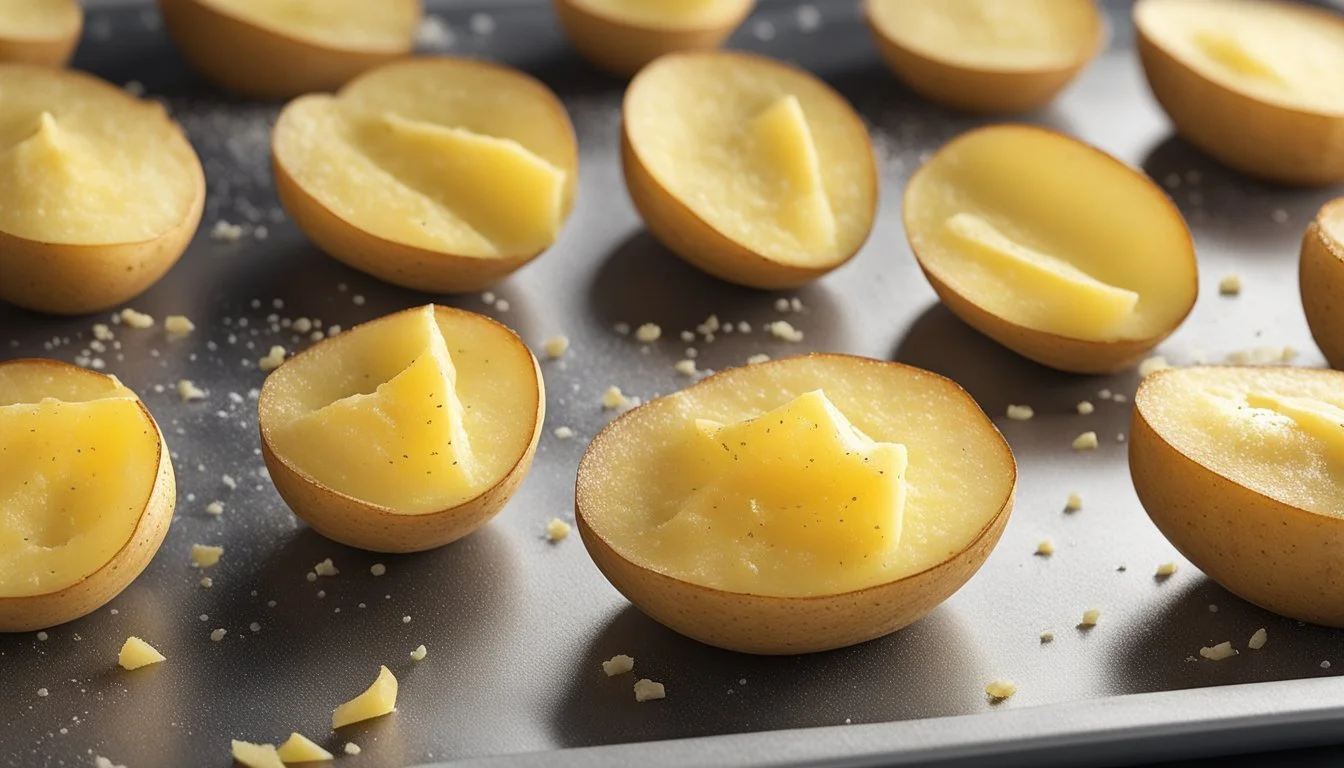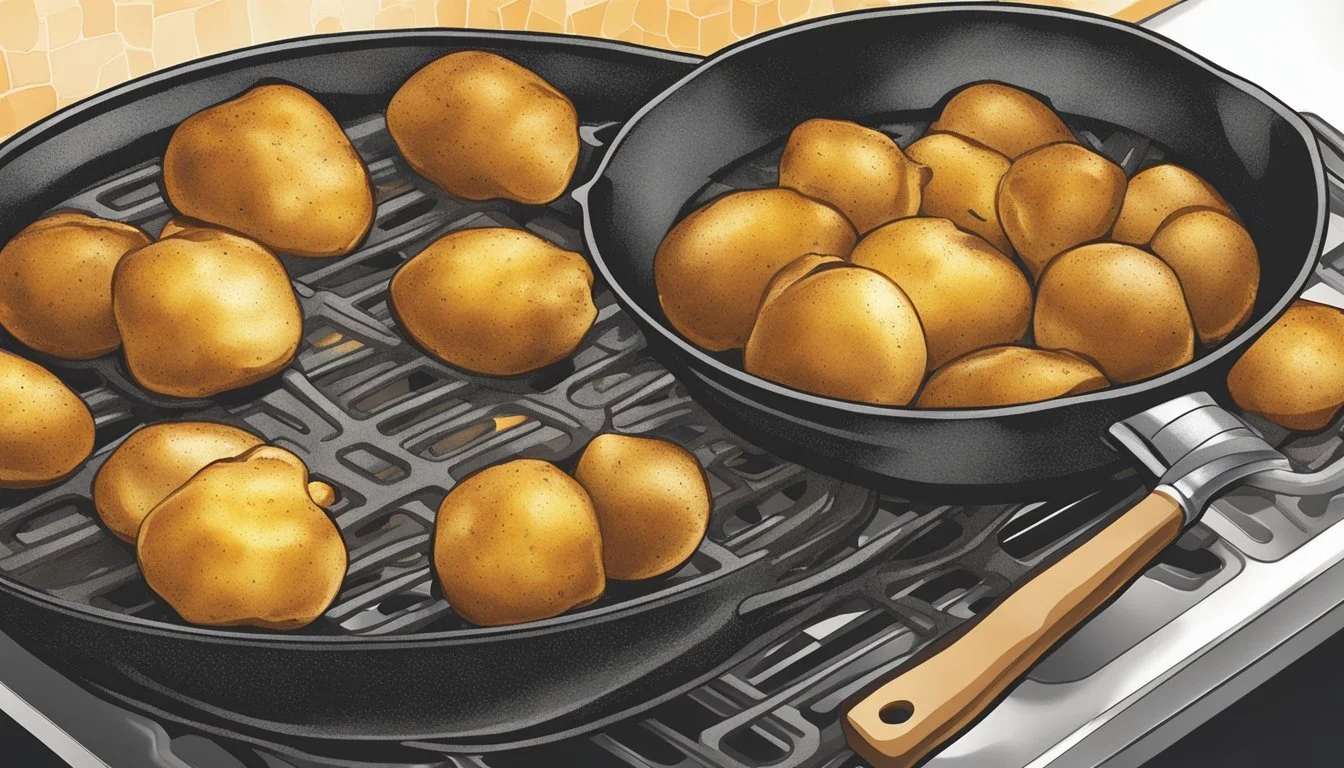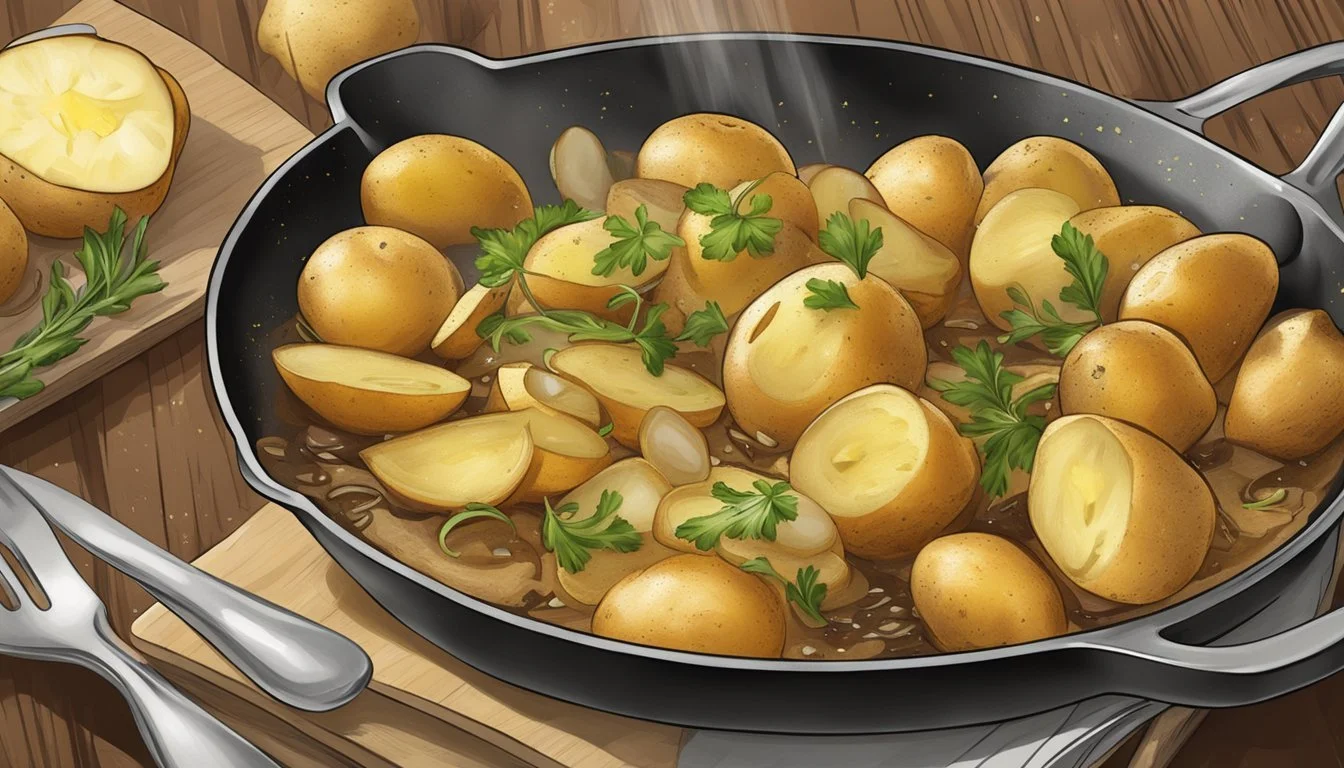Best Way to Reheat Lyonnaise Potatoes
Ensuring Crispiness and Rich Flavor
Lyonnaise potatoes, (What wine goes well with potatoes?) a classic French dish, are a beloved side known for their deliciously crispy edges and buttery, tender interior. This dish typically consists of thinly sliced potatoes and onions sautéed in butter and olive oil, seasoned with black pepper, and often garnished with parsley. Their perfect texture is a balance of a golden exterior complemented by the softness of potatoes on the inside, making them not just a side dish, but a highlight of many meals.
Ensuring that Lyonnaise potatoes maintain their distinct crispiness and flavor when reheated is crucial. Many might find it challenging to preserve the integrity of their texture and taste, as reheating can easily result in soggy potatoes. However, the right reheating method can revive the original allure of this dish, bringing back the crisp edges and buttery taste that Lyonnaise potatoes are known for.
Reheating this dish requires a technique that not only warms the potatoes but also re-crisps the exterior while keeping the interior moist. The use of an oven to reheat Lyonnaise potatoes can help achieve this goal. When executed correctly, the potatoes emerge as good as when they were first cooked, with the onions caramelized and the edges of the potatoes crisped to perfection.
Understanding Lyonnaise Potatoes
Lyonnaise potatoes are a classic French dish named after the city of Lyon. This dish combines thinly sliced potatoes with caramelized onions, typically seasoned with salt and black pepper. A key feature of Lyonnaise potatoes is their crispy texture, achieved by pan-frying the potatoes to a golden-brown excellence.
Ingredients:
Potatoes: The star of the dish, providing a sturdy base.
Onions: Adds sweetness and depth of flavor when caramelized.
Butter: Infuses the potatoes with a rich, creamy taste.
Olive oil: Helps to crisp the potatoes while adding subtle flavor.
Black pepper: Provides a sharp, warm spice that complements the other ingredients.
Preparation:
Slice: Potatoes are sliced into uniform pieces to ensure even cooking.
Pan-fry: Potatoes are initially browned in a mixture of butter and olive oil, then cooked with onions until everything is tender and golden.
Season: Salt and black pepper are used to enhance the natural flavors.
Cooking Lyonnaise potatoes requires attention to detail to preserve their texture while ensuring the flavor is well-balanced. Chefs must carefully monitor the heat to prevent the potatoes from becoming too soft or burning. It's the combination of creamy potatoes, sweet onions, and the buttery, crispy edge that makes this dish a beloved addition to meals.
Storing Lyonnaise Potatoes
Properly stored Lyonnaise potatoes can maintain their quality, though it's important to employ the right techniques to minimize spoilage and ensure safety. Here's how to best store Lyonnaise potatoes in both the fridge and freezer.
Fridge Storage Best Practices
For optimal freshness, leftovers should be stored in the refrigerator as soon as they have cooled. The U.S. Department of Agriculture recommends transferring the potatoes to an airtight container to prevent the absorption of smells and reduce the risk of drying out. Place the container on a shelf rather than in the door to maintain a consistent temperature. Foil can also be used to cover the dishes but make sure they’re sealed well.
Transfer to airtight container: Quickly reduces the risk of spoilage.
Refrigerate within 2 hours of cooking: Advised by consumer safety groups like U.S. Department of Agriculture.
Optimal fridge temperature: Between 34°F and 40°F, as per Consumer Reports.
Storage duration: Up to 3 days for best results.
Freezer Storage Techniques
If one needs to keep Lyonnaise potatoes longer than a few days, freezing is a viable option. Begin by cooling the potatoes to prevent condensation inside the container, which can lead to freezer burn. Use an airtight container or freezer bags to limit exposure to air. A crucial step is to label the container with the current date; according to Love Food Hate Waste organization, labeling helps track how long items have been frozen to keep within safety guidelines.
Cool before freezing: Prevents moisture build-up.
Use suitable containers: Airtight to prevent freezer burn.
Label with the date: Tracks the duration of storage and prevents food waste.
Storage duration: Lyonnaise potatoes can be kept for up to 3 months in the freezer.
Pre-Reheating Preparation
Before reheating Lyonnaise potatoes, one must ensure proper preparation to maintain the ideal texture and flavor. The key lies in gently restoring warmth while preserving crispness without introducing additional moisture that could lead to sogginess.
Step 1: Bring the potatoes to room temperature
It is advisable to remove the Lyonnaise potatoes from the refrigerator and let them sit for about 15 to 20 minutes. This step is crucial as it helps in even reheating and reduces the potential for moisture buildup.
Step 2: Absorb any excess moisture
While the potatoes come to room temperature, one should check for any excess moisture. If present, lightly pat them with a paper towel to ensure that the potatoes' crispness is not compromised during the reheating process.
Step 3: Preheat the oven
To recreate the perfect blend of crispy and buttery textures, preheat the oven to 400 degrees Fahrenheit. An oven is preferred over a microwave, as it allows for an all-around even distribution of heat, which is essential for achieving the right crispness.
Step 4: Arrange potatoes on a baking sheet
On a baking sheet, spread the potatoes in a single layer without crowding. Overlapping can result in uneven heating and steaming rather than crisping. If necessary, use multiple sheets to give the potatoes adequate space.
Proper preparation sets the stage for successfully reheating Lyonnaise potatoes, delivering a side dish that is as delightful as when it was first served. Follow these steps conscientiously to enjoy potatoes with restored warmth, a crisp exterior, and a buttery, tender bite.
Reheating Methods Overview
When reviving Lyonnaise potatoes, maintaining their crisp exterior and buttery interior is key. This section outlines various reheating methods to achieve the best results without compromising the potatoes' texture and flavor.
Oven Reheating Technique
To preserve crispness, one can reheat Lyonnaise potatoes in a 400-degree oven. Potatoes are typically arranged on a baking sheet in a single layer and covered with foil. This method warms them evenly and retains moisture. Removing the foil towards the end allows the potatoes to regain their crisp texture.
Skillet Reheating Method
Using a skillet over medium heat with a bit of butter can help Lyonnaise potatoes attain a crispy exterior. It's important to add the potatoes only after the butter is sizzling to ensure they don't become soggy. Covering the skillet briefly can hasten the warming process, followed by cooking uncovered to recrisp the potatoes.
Air Fryer Reheating Approach
For a quick and efficient method, the air fryer offers a perfect solution. Preheat the air fryer to 350°F and place the potatoes in the basket in a single layer. Reheat for 5-7 minutes, shaking occasionally, allowing every piece to regain its crispness uniformly.
Microwave Reheating Tips
Though not ideal for keeping potatoes crisp, the microwave can be used for a quick warm-up. Place the potatoes on a microwave-safe plate and cover them with a damp paper towel. This ensures they stay moist while being reheated at intervals of 30 seconds. It's best for those who prioritize speed over texture.
Toaster Oven Reheating Tricks
A toaster oven can be an alternative to the regular oven, especially for smaller portions. Reheat the potatoes at 400°F, similarly covered with foil and then uncovered for the last few minutes, to allow the potatoes to crisp up nicely while preventing drying out.
Each of these methods has its own set of benefits, depending on the texture preferences and the equipment available.
Ensuring Crispiness & Texture
When reheating Lyonnaise potatoes, the ultimate goal is to achieve that ideal balance of a buttery interior and a crisp exterior. Proper moisture control, surface crisping techniques, and even heat distribution are fundamental to success.
Monitoring Moisture Content
To maintain the desired texture of Lyonnaise potatoes, one must carefully monitor their moisture content. Excess moisture is the enemy of crispness, and thus, it's pivotal to use methods that do not trap steam. Covering the potatoes with foil can lead to soggy results. Instead, using parchment paper as a cover can help absorb some moisture while allowing sufficient airflow.
Maintaining Crispy Exterior
The exterior of the potatoes should be sufficiently crispy to offer a textural contrast. Prior to reheating, a light coat of oil can help reestablish the potatoes' crispiness. It's advisable to place the potatoes on a preheated baking sheet, as this assists in promptly recreating a crispy crust upon contact due to the immediate high heat.
Key Points:
Lightly oil the potatoes before reheating.
Use a preheated baking sheet to aid in crisping.
Even Heat Distribution
Even heat distribution in the oven is critical. The potatoes should be spread out in a single layer on the baking sheet to ensure each piece is evenly heated and crisped. Avoid overcrowding, which can result in uneven cooking and reduced crispness. The oven temperature should be high enough, ideally around 400°F (200°C), to reheat the potatoes quickly and help in recapturing their crisp texture.
Steps for Optimal Heat Distribution:
Preheat oven to 400°F (200°C).
Arrange potatoes in a single layer.
Turn potatoes halfway through reheating.
Seasoning and Flavor Enhancement
When reheating Lyonnaise potatoes, the key to maintaining their signature taste lies in the careful management of seasoning and flavor. Salt and pepper are fundamental, providing a base flavor that complements the buttery notes of the potatoes. While reheating, one should consider a light additional sprinkle of these essential seasonings to revive the flavors that might have been muted during refrigeration.
Garlic, parsley, and thyme traditionally play a pivotal role in the profile of Lyonnaise potatoes, infusing them with a herby freshness and a pleasant aroma. These should be added fresh if the potatoes were not initially seasoned with them, or they can be gently refreshed during the reheating process. An important tip is to avoid burning the garlic; it should be incorporated in a way that ensures it warms through and releases its flavor without turning bitter.
For the finishing touch right before serving, a small sprinkle of fresh, chopped parsley not only enhances the flavor but also adds a pop of color to the dish. It's worth noting that fine-tuning the seasonings before serving is recommended, as the taste test is critical to achieving the perfect balance that defines a well-prepared Lyonnaise potato dish.
Key Ingredients Purpose Usage Tip Salt Enhances overall flavor Adjust according to taste after reheating Pepper Adds depth and a slight kick A fresh grind can revive the dish's spiciness Parsley Offers a fresh, herby note Best added fresh before serving Thyme Imparts a subtle, earthy undertone Should be aromatic but not overpowering Garlic Gives a pungent, appetizing flavor Include in moderation and avoid overcooking
By paying close attention to these seasonings and flavors, reheated Lyonnaise potatoes can be as delightful as they were when first served.
Serving and Pairing Suggestions
When serving Lyonnaise potatoes, whether freshly made or reheated, maintaining their signature crispy and buttery texture is key. They are a versatile side dish that pairs excellently with a variety of proteins and vegetables.
Chicken: A classic companion, Lyonnaise potatoes complement the subtlety of roasted or grilled chicken. The rich flavors of the potatoes stand up well against the savory taste of the poultry.
Steak: For a hearty meal, serve alongside a juicy steak. The boldness of the beef pairs perfectly with the slight oniony note and the crispiness of the potatoes.
Salad: Offset the richness of Lyonnaise potatoes with a light, fresh salad. The contrasting textures and flavors can make for a balanced and satisfying meal.
It's not uncommon to have leftover roasted potatoes. In such cases, converting them into Lyonnaise potatoes can breathe new life into them for another meal.
Serving Suggestions Description As a standalone side dish Their crispiness makes them delightful on their own. In a combo with proteins They can be the star supporting act next to a main protein. Part of a meal component Include them within a larger meal plan, like brunch buffets.
For those who might wonder about turning leftover crispy roast potatoes into Lyonnaise potatoes, it's feasible and encouraged. The already present crispiness will be enhanced with the reheating process, ensuring no waste and a delightful eating experience. Remember to keep the serving size moderate to allow each element of the meal to shine.
Safety and Health Considerations
When reheating Lyonnaise potatoes, one should prioritize safety and health to prevent foodborne illnesses. The U.S. Department of Agriculture (USDA) recommends that all cooked foods reach a safe internal temperature to kill off any bad bacteria. Potatoes should be reheated to at least 165 degrees Fahrenheit to ensure they are safe to eat.
Reheating using an oven or an air fryer is an excellent choice, as these methods help to avoid the soft texture that microwaving might cause. If using a microwave, cover the potatoes with a damp paper towel to maintain moisture and prevent them from drying out. It's important to avoid using plastic wrap that is not microwave-safe, as it can melt and potentially contaminate the food with chemicals.
Here are a few key tips:
Monitor Temperature: Use a food thermometer to ensure your potatoes have reached a safe temperature.
Store Properly: Before reheating, ensure that your potatoes have been stored correctly, ideally in a refrigerator set below 40 degrees Fahrenheit to slow the growth of bad bacteria.
Keep Moisture in Check: Use moist heat to maintain the potatoes’ texture, but also to ensure an even and safe reheating process.
Avoid Cross-Contamination: Always use clean utensils and plates to prevent the introduction of new bacteria.
By following these guidelines, you can enjoy your Lyonnaise potatoes not only with the desired crispy and buttery goodness but also with the assurance that they are safe to consume.
Minimizing Waste and Maximizing Enjoyment
Proper reheating of Lyonnaise potatoes is key to maintaining their desirable qualities. The goal is to revive the potatoes' crispiness without making them too dry or oily. Initiatives like 'Love Food Hate Waste' emphasize the importance of managing leftovers in a way that maintains food quality and reduces waste. Following best practices not only preserves the delectable texture and flavor but also aligns with responsible consumption.
Reheating in the Oven:
Preheat the oven to 350°F (175°C).
Spread the potatoes in a single layer on a baking sheet.
Reheat for 10-15 minutes, checking periodically for crispiness.
Using an oven retains the texture and is particularly well-suited for larger amounts.
Reheating in the Microwave:
Place potatoes in a microwave-safe dish.
Cover with a microwave-safe lid to avoid splatter.
Heat in short intervals, checking frequently to prevent overcooking.
The microwave is a quicker method but requires careful monitoring to achieve the right crispness.
Tips for Quality Preservation:
Allow leftovers to cool before refrigerating.
Store in airtight containers to keep them fresh.
Consumer Reports suggests that proper storage can significantly impact the taste and quality when reheating. By minimizing waste through efficient reheating methods, one maximizes the enjoyment of these versatile potatoes. Great attention to detail and minimal effort can ensure that the reheated Lyonnaise potatoes offer great satisfaction, aligning with assured and diligent food practices.
Lyonnaise Potatoes in Culinary Culture
Lyonnaise potatoes have secured their place as a cherished side dish in French culinary tradition. Originating from Lyon, France's gastronomic hub, this dish highlights the simple yet harmonious combination of pan-fried potatoes and caramelized onions. Its rustic charm captures the essence of French comfort food that resonates with Southern Living.
Ingredients:
Thinly sliced onions
Butter for frying
Seasonings (traditionally salt and pepper)
In their preparation, thinly sliced potatoes are initially boiled until tender yet firm, then pan-fried in butter until they attain a golden-brown crispness. Concurrently, onions are sliced and slow-cooked until they caramelize, developing a deep, sweet flavor profile that pairs flawlessly with the earthiness of the potatoes.
Lyonnaise potatoes, while modest in their ingredient list, demand technical skill to balance textures and flavors. They are a testament to the art of French cooking—where technique is pivotal to transforming simple ingredients into exquisite dishes. The dish's success lies in achieving the desirable contrast between the crispy potatoes and the soft, sweet onions.
The term "Lyonnaise" reflects its affiliation with the city of Lyon, signaling its prominence in the local gastronomy. As this dish continues being served across regions, it brings along a taste of the culinary wealth of Lyon, embedding itself into the international lexicon of French cuisine.







